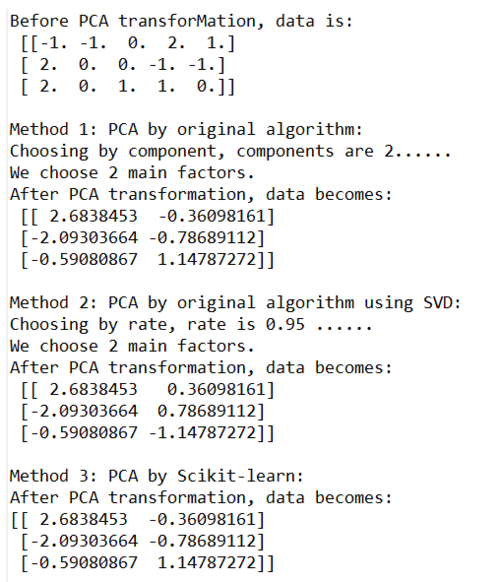主成分分析,即Principal Component Analysis(PCA),是多元统计中的重要内容,也广泛应用于机器学习和其它领域。它的主要作用是对高维数据进行降维。PCA把原先的n个特征用数目更少的k个特征取代,新特征是旧特征的线性组合,这些线性组合最大化样本方差,尽量使新的k个特征互不相关。关于PCA的更多介绍,请参考:https://en.wikipedia.org/wiki/Principal_component_analysis.
PCA的主要算法如下:
组织数据形式,以便于模型使用;
计算样本每个特征的平均值;
每个样本数据减去该特征的平均值(归一化处理);
求协方差矩阵;
找到协方差矩阵的特征值和特征向量;
对特征值和特征向量重新排列(特征值从大到小排列);
对特征值求取累计贡献率;
对累计贡献率按照某个特定比例,选取特征向量集的字迹合;
对原始数据(第三步后)。
其中协方差矩阵的分解可以通过按对称矩阵的特征向量来,也可以通过分解矩阵的SVD来实现,而在Scikit-learn中,也是采用SVD来实现PCA算法的。关于SVD的介绍及其原理,可以参考:矩阵的奇异值分解(SVD)(理论)。
本文将用三种方法来实现PCA算法,一种是原始算法,即上面所描述的算法过程,具体的计算方法和过程,可以参考:A tutorial on Principal Components Analysis, Lindsay I Smith. 一种是带SVD的原始算法,在Python的Numpy模块中已经实现了SVD算法,并且将特征值从大从小排列,省去了对特征值和特征向量重新排列这一步。最后一种方法是用Python的Scikit-learn模块实现的PCA类直接进行计算,来验证前面两种方法的正确性。
用以上三种方法来实现PCA的完整的Python如下:
import numpy as npfrom sklearn.decomposition import PCAimport sys#returns choosing how many main factorsdef index_lst(lst, component=0, rate=0):
#component: numbers of main factors
#rate: rate of sum(main factors)/sum(all factors)
#rate range suggest: (0.8,1)
#if you choose rate parameter, return index = 0 or less than len(lst)
if component and rate:
print('Component and rate must choose only one!')
sys.exit(0) if not component and not rate:
print('Invalid parameter for numbers of components!')
sys.exit(0) elif component:
print('Choosing by component, components are %s......'%component) return component else:
print('Choosing by rate, rate is %s ......'%rate) for i in range(1, len(lst)): if sum(lst[:i])/sum(lst) >= rate: return i return 0def main():
# test data
mat = [[-1,-1,0,2,1],[2,0,0,-1,-1],[2,0,1,1,0]]
# simple transform of test data
Mat = np.array(mat, dtype='float64')
print('Before PCA transforMation, data is:\n', Mat)
print('\nMethod 1: PCA by original algorithm:')
p,n = np.shape(Mat) # shape of Mat
t = np.mean(Mat, 0) # mean of each column
# substract the mean of each column
for i in range(p): for j in range(n):
Mat[i,j] = float(Mat[i,j]-t[j])
# covariance Matrix
cov_Mat = np.dot(Mat.T, Mat)/(p-1)
# PCA by original algorithm
# eigvalues and eigenvectors of covariance Matrix with eigvalues descending
U,V = np.linalg.eigh(cov_Mat)
# Rearrange the eigenvectors and eigenvalues
U = U[::-1] for i in range(n):
V[i,:] = V[i,:][::-1] # choose eigenvalue by component or rate, not both of them euqal to 0
Index = index_lst(U, component=2) # choose how many main factors
if Index:
v = V[:,:Index] # subset of Unitary matrix
else: # improper rate choice may return Index=0
print('Invalid rate choice.\nPlease adjust the rate.')
print('Rate distribute follows:')
print([sum(U[:i])/sum(U) for i in range(1, len(U)+1)])
sys.exit(0) # data transformation
T1 = np.dot(Mat, v) # print the transformed data
print('We choose %d main factors.'%Index)
print('After PCA transformation, data becomes:\n',T1)
# PCA by original algorithm using SVD
print('\nMethod 2: PCA by original algorithm using SVD:') # u: Unitary matrix, eigenvectors in columns
# d: list of the singular values, sorted in descending order
u,d,v = np.linalg.svd(cov_Mat)
Index = index_lst(d, rate=0.95) # choose how many main factors
T2 = np.dot(Mat, u[:,:Index]) # transformed data
print('We choose %d main factors.'%Index)
print('After PCA transformation, data becomes:\n',T2)
# PCA by Scikit-learn
pca = PCA(n_components=2) # n_components can be integer or float in (0,1)
pca.fit(mat) # fit the model
print('\nMethod 3: PCA by Scikit-learn:')
print('After PCA transformation, data becomes:')
print(pca.fit_transform(mat)) # transformed data
main()运行以上代码,输出结果为:
Eclipse运行结果
这说明用以上三种方法来实现PCA都是可行的。这样我们就能理解PCA的具体实现过程啦~~
有兴趣的读者可以用其它语言实现一下哈。
参考文献:
PCA 维基百科: https://en.wikipedia.org/wiki/Principal_component_analysis.
讲解详细又全面的PCA教程: A tutorial on Principal Components Analysis, Lindsay I Smith.
博客:矩阵的奇异值分解(SVD)(理论):http://www.cnblogs.com/jclian91/p/8022426.html.
博客:主成分分析PCA: https://www.cnblogs.com/zhangchaoyang/articles/2222048.html.
Scikit-learn的PCA介绍:http://scikit-learn.org/stable/modules/generated/sklearn.decomposition.PCA.html.
作者:但盼风雨来_jc
链接:https://www.jianshu.com/p/9cf498a1ab56
共同学习,写下你的评论
评论加载中...
作者其他优质文章







